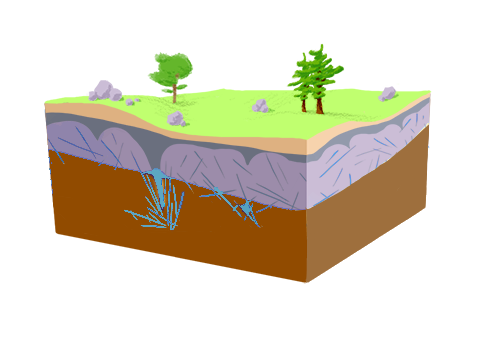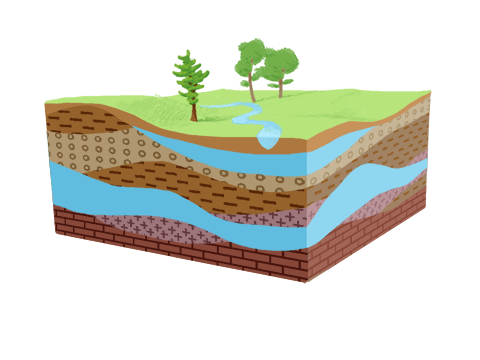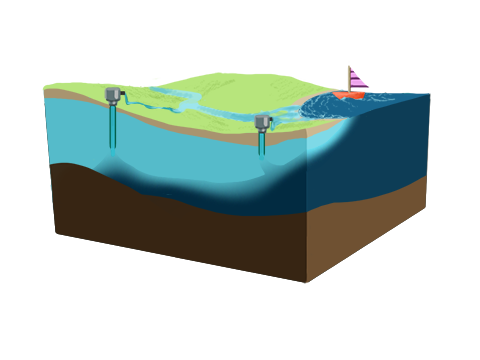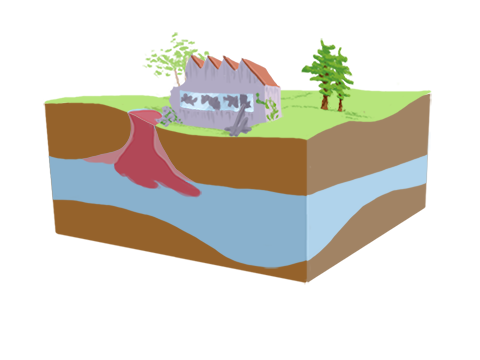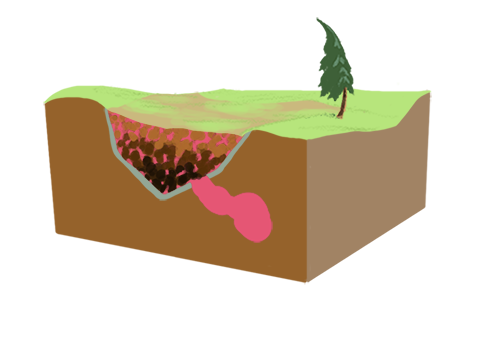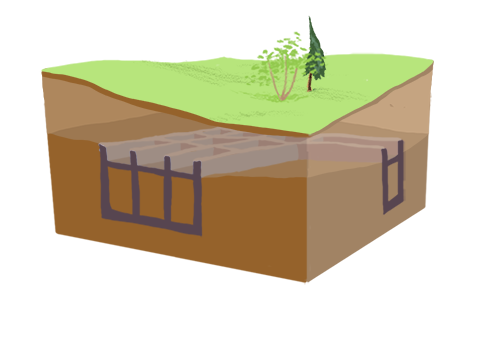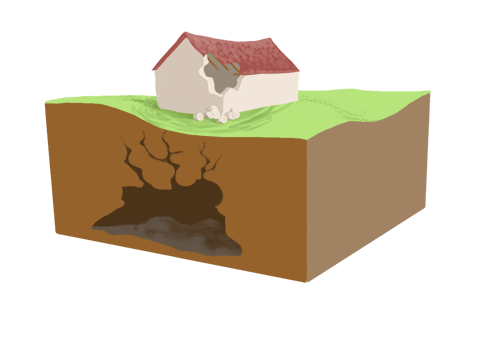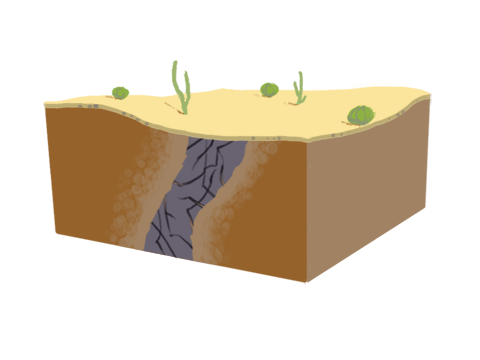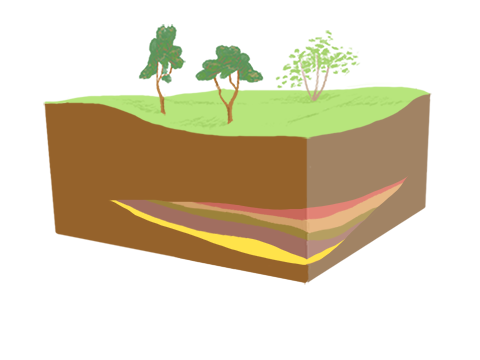Locate fault or dyke
In arid regions located on metamorphic rock-type geology, the weathered bedrock generally doesn’t contain groundwater anymore. In this case, people can be forced to extract water contained in the unweathered rock at large depth.
In order to be able to extract water, people have to find low permeability areas generally located in fault zones.
The Syscal instrument range is well adapted to locate shallow to deep fault or dyke by sounding or profiling the soil (Syscal Junior / Syscal R1 / Syscal R2 / Syscal Pro).
The Syscal Switch range of equipment can also be used to perform shallow to deep electrical resistivity tomographies (Syscal Junior Switch / Syscal R1 Switch / Syscal Pro Switch).
The Promis 10 slingram type EM profiler or the T-VLF can also be useful to detect faults that are generally filled with clay (conductive) or not (resistive).
Finally, the VIP range transmitter associated with the Elrec range receivers are very well adapted to locate deep fractures in the unweathered bedrock.
water table detection
In sedimentary geology, the groundwater is generally located in ground water tables. Depending on the soil/rock porosity, soil/rock permeability and sometime fracture and karstic network, the number of ground water table, their thickness and their spatial heterogeneity may vary greatly. In order to locate the most favorable site to setup a drilling, several geophysical investigations can be done using:
The Syscal instrument range to locate water table depths and thicknesses by sounding (Syscal Junior / Syscal R1 / Syscal R2 / Syscal Pro).
The Syscal Switch range of equipment can also be used to perform shallow to deep electrical resistivity tomographies (Syscal Junior Switch / Syscal R1 Switch / Syscal Pro Switch).
The VIP range transmitter associated with the Elrec range receivers can be used for deep electrical soundings and tomographies.
Finally, the Numis range equipment can be used to directly estimate ground water volumes, porosity and permeability.
Salt water wedge
In coastal areas, the multiplication of groundwater pumping can sometime modify the natural salt water wedge and create salted water intrusion under land area. This intrusion may have a catastrophic impact on water resource, agriculture and industry.
To measure the extension of the salt water wedge in lands, electrical resistivity soundings, tomography or monitoring can be performed with the Syscal and Syscal Switch range (Syscal Junior / Syscal Junior Switch / Syscal R1 / Syscal R1 Switch / Syscal R2 / Syscal Pro / Syscal Pro Switch).
The measurement of the soil electrical resistivity can also be performed using the Promis 10 Slingram type EM profiler that allows to measure the soil electrical resistivity with a high productivity.
Pollution monitoring
The location and temporal extension of soil pollution is of paramount importance for land-use planning, agriculture, water resources and soil depollution. According to the type of pollution, electrical resistivity or induced polarization can be linked to the presence of pollutants. The Syscal and Syscal Switch range will allow to locate, determine the spatial extension and monitor such pollutions (Syscal Kid / Syscal Kid Switch / Syscal Junior / Syscal Junior Switch / Syscal R1 / Syscal R1 Switch / Syscal R2 / Syscal Pro / Syscal Pro Switch).
For large areas, the pollution extension can be determined more easily and rapidly using the Promis 10 slingram type EM profiler to realize resistivity maps.
Waste disposal
Waste disposal are objects that need to remain under supervision during their whole lifetime. The first aspect of this supervision consists in checking the proper containment of wastes to avoid lixivia’s leak through the geomembrane and through the possible clayey layers. The second aspect deals with the monitoring of the homogeneous circulation of lixivia in the waste disposal to ensure an optimal degradation. The Syscal Switch range will allow to locate, determine the spatial extension and monitor the proper functioning of a waste disposal site (Syscal Junior Switch / Syscal R1 Switch / Syscal Pro Switch).
Buried structure
During archeological studies, the determination of the location and of the spatial extension of the buried structures (e.g. walls of ancient buildings) allows to determine precisely the area of investigation and the geometry of the buried structure. Electrical resistivity has been shown useful to image remains of buildings, graves and other traces of ancient human activity. The Syscal range is well adapted to image such structures at shallow depth (Syscal Kid Switch, Syscal Junior Switch).
Cavities
Cavities generally occurring in calcareous soils (karst) or due to mining activity may constitute a real danger for all type of activity on the ground surface. The cavity may create ground surface subsidence to sinkhole, generating from fissure in the masonry to the total collapse of building. This phenomenon can also occur in dams. In all cases, the early detection of cavity is the only way to minimize risk for population and structures. Usually employed complementarily to other methods, the electrical resistivity tomography may be sensitive to the presence of cavities. The Syscal Switch range is therefore well adapted to this type of applications (Syscal R1 Switch / Syscal Pro Switch).
The Promis 10 slingram type EM profiler can also be adapted to image long linear or surface (such as for dams).
Landslide
Landslide is one of the major natural hazard in the world. Whether ancient and reactivated or recently triggered, the knowledge of the slip surface depth and geometry allow to estimate the landslide volume to analyze the risk for population and buildings. The Syscal and Syscal Switch range are well adapted to such applications (Syscal Junior / Syscal Junior Switch / Syscal R1 / Syscal R1 Switch / Syscal R2 / Syscal Pro / Syscal Pro Switch).
Recently, several research works have shown the possibility of monitoring landslide activity using ERT with the possibility of tracking deformations, infiltrations and soil water content variations with time. The Syscal Pro Switch is well adapted for monitoring applications of shallow to slightly deep landslides.
To investigate deeper landslides, we advise the use of the VIP range associated with the Elrec range.
Finally, to map landslides over large areas, the Promis 10 slingram type EM profiler can help to highlight conductive anomalies over an area, linked to the presence of landslides.
Geotechnics
Geotechnics can benefit greatly from geophysics. It can be used to identify different contrasted soil layers, to position drillings, to detect depth of foundations or to monitor soil remediation work such as resign infiltration. In all that cases, the Syscal and Syscal Switch ranges are well adapted to sound or image the soil electrical resistivity (Syscal Junior / Syscal Junior Switch / Syscal R1 / Syscal R1 Switch / Syscal R2 / Syscal Pro / Syscal Pro Switch).
The Promis 10 slingram type EM profiler can also be used to assess the lateral extension and depth of clayey layers for large areas.
Detect dike
For mining exploration applications, the method and equipment to use depend on how the precious metal is concentrated or disseminated in rocks, on the size of the orebody but also on its depth. When precious metal is concentrated in a dyke, the detection may be performed by resistivity profiling using the Promis 10 Slingram type EM profiler or the T-VLF to image resistivity or the Syscal range equipment to measure electrical resistivity or induced polarization (Syscal R1 / Syscal R2 / Syscal Pro).
The dyke can also be imaged by the acquisition of electrical resistivity and induced polarization using the Syscal Switch range (Syscal R1 Switch / Syscal Pro Switch).
For deep application and induced polarization measurement, prefer the use of separate transmitter and receiver by using the TIPIX or VIP transmitter ranges associated to the Elrec of Fullwaver ranges of receiver. This method allows for sounding, profiling and imaging electrical resistivity and chargeability of the soil.
Deep orebody
For mining exploration applications, the method and equipment to use depend on how the precious metal is concentrated or disseminated in rocks, on the size of the orebody but also on its depth. The deep orebodies are generally difficult to image with geophysics and can require large 2D/3D tomography to estimate volumes. The VIP range of transmitters combined with the I & V Fullwaver equipment are dedicated to this type of applications. The setup of several tens of static V Fullwavers (cableless) combined with the I Fullwaver that measure and store the current injected by the VIP transmitter, allow to measure, store, process and easily extract a 3D model of electrical resistivity and induced polarization.
A work in 2D or 3D is also possible using the Elrec Pro receiver associated with the switch Pro boxes and cables.
Lens type orebody
For mining exploration applications, the method and equipment to use depend on how the precious metal is concentrated or disseminated in rocks, on the size of the orebody but also on its depth. Depending on its depth, lens type orebody can be detected by 2D or 3D tomography which is completed with TIPIX or VIP range transmitters associated with the Elrec range receivers.
For large and deep lens type orebody, the setup of several tens of static V Fullwavers (cableless) combined with the I Fullwaver that measure and store the current injected by the VIP transmitter, allow to measure, store, process and easily extract a 3D model of electrical resistivity and induced polarization.






